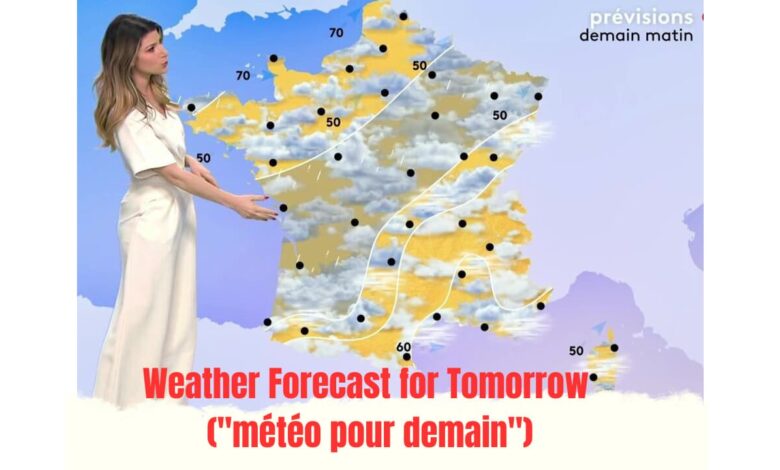Weather Forecast for Tomorrow (“météo pour demain”)

Understanding the weather forecast, or “météo pour demain,” is essential for planning your day. Whether you’re preparing for a weekend getaway, a work commute, or an outdoor event, accurate weather information helps you make informed decisions. This article provides a detailed and SEO-optimized overview of how to interpret and use weather forecasts, specifically focusing on the resources available through Environment Canada’s official weather website.
Introduction: Why Weather Forecasts Matter
Weather forecasts play a crucial role in our daily lives, offering insights into temperature, precipitation, wind speed, and more. Knowing what to expect can help you dress appropriately, protect your property, and even make important business decisions. This guide will explore the various aspects of weather forecasting, with a particular focus on the keyword “météo pour demain.”
The Science Behind Weather Forecasting
Weather forecasting is a complex science that involves gathering data from various sources, including satellites, weather stations, and radars. Meteorologists use this data to create models that predict future weather patterns. These models consider factors like temperature, humidity, wind patterns, and atmospheric pressure to provide accurate forecasts.
How to Use Environment Canada’s Weather Forecasts
Environment Canada offers a comprehensive weather forecasting service that covers all regions of Canada. The website provides detailed forecasts for the next day (“météo pour demain”), including temperature ranges, precipitation levels, and wind conditions. Here’s how to navigate the site for the best results:
Accessing the Forecast
To access the weather forecast for tomorrow, visit the official Environment Canada website. Select your region from the dropdown menu, and you’ll be directed to a detailed forecast page.
Interpreting the Data
The forecast page provides a wealth of information, including temperature highs and lows, chances of precipitation, and wind speeds. The data is presented in both graphical and textual formats, making it easy to understand at a glance.
Temperature
Temperature is usually the first thing people check in a weather forecast. Environment Canada provides both daytime highs and nighttime lows, allowing you to plan your activities accordingly.
Precipitation
Precipitation forecasts are crucial, especially if you plan to spend time outdoors. The site provides a percentage chance of precipitation, which helps you gauge the likelihood of rain, snow, or other forms of precipitation.
Wind Speed and Direction
Wind conditions can significantly impact your day, especially if you’re involved in activities like boating or cycling. Environment Canada’s forecasts include wind speed and direction, giving you a complete picture of what to expect.
The Importance of Checking the Weather Daily
Checking the weather forecast for tomorrow (“météo pour demain”) should be a daily habit. Weather conditions can change rapidly, and staying informed helps you avoid being caught off guard. Whether you’re planning a trip, commuting to work, or organizing an outdoor event, knowing the weather can save you time and hassle.
Common Weather Terms and Their Meanings
Understanding common weather terms can help you better interpret the forecast. Here are some key terms you’ll encounter:
Barometric Pressure
Barometric pressure is the measure of atmospheric pressure in a specific area. It’s a key indicator of weather patterns, with falling pressure often indicating stormy weather and rising pressure suggesting fair conditions.
Humidity
Humidity refers to the amount of moisture in the air. High humidity can make temperatures feel hotter, while low humidity can make the air feel cooler and more comfortable.
UV Index
The UV index measures the strength of ultraviolet radiation from the sun. A high UV index indicates a greater risk of skin damage from sun exposure, making it essential to take precautions like wearing sunscreen.
How Weather Forecasts Impact Daily Life
Weather forecasts influence many aspects of daily life, from what you wear to how you travel. Here’s a closer look at how knowing the weather for tomorrow (“météo pour demain”) can affect your day:
Travel Plans
Whether you’re driving, flying, or taking public transportation, weather conditions can impact your journey. Severe weather can cause delays, so it’s important to check the forecast before you leave.
Outdoor Activities
If you’re planning outdoor activities like hiking, camping, or sports, knowing the weather forecast helps you prepare. For example, if rain is predicted, you can pack waterproof gear or consider rescheduling.
Health Considerations
Weather can also affect your health. Cold temperatures can exacerbate conditions like arthritis, while high heat and humidity can lead to dehydration or heatstroke. By checking the forecast, you can take steps to protect your well-being.
Tips for Making the Most of Weather Forecasts
To get the most out of your weather forecast, consider these tips:
Use Multiple Sources
While Environment Canada provides reliable forecasts, it’s a good idea to consult other sources as well. Websites like The Weather Channel and AccuWeather offer additional perspectives that can help you make more informed decisions.
Check the Forecast Frequently
Weather conditions can change rapidly, so it’s important to check the forecast multiple times throughout the day. This is especially true if you’re planning activities that are sensitive to weather changes.
Understand the Limitations
While weather forecasting is highly advanced, it’s not infallible. Factors like sudden changes in atmospheric pressure or unexpected weather fronts can lead to inaccuracies. It’s always a good idea to have a backup plan in case the forecast doesn’t hold.
The Role of Technology in Weather Forecasting
Advancements in technology have significantly improved the accuracy of weather forecasts. Satellites, radar systems, and computer models allow meteorologists to predict weather patterns with greater precision. Here’s a look at how technology is shaping the future of weather forecasting:
Satellite Imagery
Satellites provide real-time images of weather systems as they develop. This data is crucial for tracking storms, hurricanes, and other severe weather events.
Radar Systems
Radar systems are used to detect precipitation, including rain, snow, and hail. By analyzing radar data, meteorologists can predict the intensity and duration of these events.
Computer Models
Computer models simulate the Earth’s atmosphere, allowing meteorologists to predict how weather systems will evolve. These models consider a wide range of variables, making them a powerful tool for forecasting.
The Benefits of Understanding Weather Patterns
By understanding weather patterns, you can make better decisions in your personal and professional life. For example, businesses can use weather data to optimize operations, while farmers can plan planting and harvesting schedules based on seasonal forecasts.
Agricultural Planning
Farmers rely on weather forecasts to plan their planting and harvesting schedules. By understanding long-term weather patterns, they can maximize crop yields and reduce the risk of weather-related damage.
Business Operations
Businesses, especially those in the logistics and transportation sectors, use weather forecasts to plan operations. Knowing the weather for tomorrow (“météo pour demain”) helps them avoid delays and ensure timely deliveries.
Environmental Impact of Weather
Weather not only affects our daily lives but also has a significant impact on the environment. Understanding these effects can help us make more sustainable choices:
Soil Erosion
Heavy rainfall can lead to soil erosion, especially in areas with poor vegetation cover. By understanding weather patterns, we can take steps to prevent erosion and protect our environment.
Water Resources
Weather patterns affect water resources, including rivers, lakes, and reservoirs. Droughts and heavy rainfall can impact water availability, making it essential to monitor weather conditions closely.
Conclusion: The Importance of Staying Informed
In conclusion, understanding the weather forecast for tomorrow (“météo pour demain”) is essential for making informed decisions. Whether you’re planning your day, preparing for an event, or managing a business, accurate weather information is invaluable. By regularly checking the forecast, using multiple sources, and understanding common weather terms, you can stay ahead of the weather and ensure your plans go smoothly.




